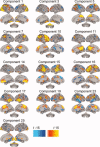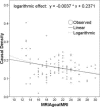Changes in the interaction of resting-state neural networks from adolescence to adulthood
- PMID: 19172655
- PMCID: PMC6788906
- DOI: 10.1002/hbm.20673
Changes in the interaction of resting-state neural networks from adolescence to adulthood
Abstract
This study examined how the mutual interactions of functionally integrated neural networks during resting-state fMRI differed between adolescence and adulthood. Independent component analysis (ICA) was used to identify functionally connected neural networks in 100 healthy participants aged 12-30 years. Hemodynamic timecourses that represented integrated neural network activity were analyzed with tools that quantified system "causal density" estimates, which indexed the proportion of significant Granger causality relationships among system nodes. Mutual influences among networks decreased with age, likely reflecting stronger within-network connectivity and more efficient between-network influences with greater development. Supplemental tests showed that this normative age-related reduction in causal density was accompanied by fewer significant connections to and from each network, regional increases in the strength of functional integration within networks, and age-related reductions in the strength of numerous specific system interactions. The latter included paths between lateral prefrontal-parietal circuits and "default mode" networks. These results contribute to an emerging understanding that activity in widely distributed networks thought to underlie complex cognition influences activity in other networks.
(c) 2009 Wiley-Liss, Inc.
Figures



Similar articles
-
Increased sensitivity to age-related differences in brain functional connectivity during continuous multiple object tracking compared to resting-state.Neuroimage. 2017 Mar 1;148:364-372. doi: 10.1016/j.neuroimage.2017.01.048. Epub 2017 Jan 20. Neuroimage. 2017. PMID: 28111190
-
Network-specific effects of age and in-scanner subject motion: a resting-state fMRI study of 238 healthy adults.Neuroimage. 2012 Nov 15;63(3):1364-73. doi: 10.1016/j.neuroimage.2012.08.004. Epub 2012 Aug 10. Neuroimage. 2012. PMID: 22992492
-
Stimulus-Elicited Connectivity Influences Resting-State Connectivity Years Later in Human Development: A Prospective Study.J Neurosci. 2016 Apr 27;36(17):4771-84. doi: 10.1523/JNEUROSCI.0598-16.2016. J Neurosci. 2016. PMID: 27122035 Free PMC article.
-
Functionally linked resting-state networks reflect the underlying structural connectivity architecture of the human brain.Hum Brain Mapp. 2009 Oct;30(10):3127-41. doi: 10.1002/hbm.20737. Hum Brain Mapp. 2009. PMID: 19235882 Free PMC article.
-
fMRI functional connectivity applied to adolescent neurodevelopment.Annu Rev Clin Psychol. 2015;11:361-77. doi: 10.1146/annurev-clinpsy-032814-112753. Epub 2015 Jan 2. Annu Rev Clin Psychol. 2015. PMID: 25581237 Free PMC article. Review.
Cited by
-
Earlier adolescent substance use onset predicts stronger connectivity between reward and cognitive control brain networks.Dev Cogn Neurosci. 2015 Dec;16:121-129. doi: 10.1016/j.dcn.2015.07.002. Epub 2015 Jul 17. Dev Cogn Neurosci. 2015. PMID: 26215473 Free PMC article.
-
Adolescent resting state networks and their associations with schizotypal trait expression.Front Syst Neurosci. 2010 Aug 5;4:35. doi: 10.3389/fnsys.2010.00035. eCollection 2010. Front Syst Neurosci. 2010. PMID: 20844603 Free PMC article.
-
The impact of serotonin transporter genotype on default network connectivity in children and adolescents with autism spectrum disorders.Neuroimage Clin. 2012 Nov 7;2:17-24. doi: 10.1016/j.nicl.2012.10.008. eCollection 2012. Neuroimage Clin. 2012. PMID: 24179754 Free PMC article.
-
The Neonatal Connectome During Preterm Brain Development.Cereb Cortex. 2015 Sep;25(9):3000-13. doi: 10.1093/cercor/bhu095. Epub 2014 May 15. Cereb Cortex. 2015. PMID: 24833018 Free PMC article.
-
Stress-induced activation of the HPA axis predicts connectivity between subgenual cingulate and salience network during rest in adolescents.J Child Psychol Psychiatry. 2011 Oct;52(10):1026-34. doi: 10.1111/j.1469-7610.2011.02422.x. Epub 2011 Jun 3. J Child Psychol Psychiatry. 2011. PMID: 21644985 Free PMC article.
References
-
- Bell AJ,Sejnowski TJ ( 1995): An information‐maximization approach to blind separation and blind deconvolution. Neural Comput 7: 1129–1159. - PubMed
-
- Blakemore SJ,Choudhury S ( 2006): Development of the adolescent brain: Implications for executive function and social cognition. J Child Psychol Psychiatry 47: 296–312. - PubMed
-
- Bollobas B ( 1985): Random Graphs. London: Academic Press.
MeSH terms
Grants and funding
LinkOut - more resources
Full Text Sources
Medical
Miscellaneous

